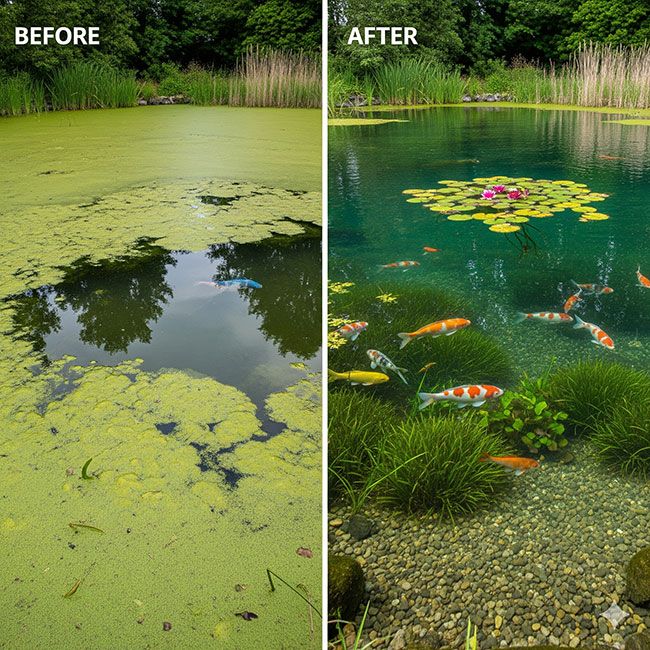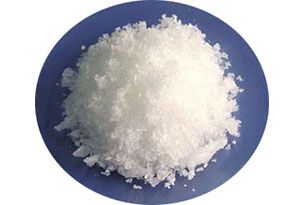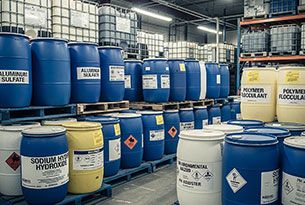Introduction to Algae Control Challenges and Lanthanum Chloride
Algae blooms in water bodies like ponds, pools, golf courses, and large aquariums can be a persistent issue, often fueled by excess phosphates that promote unwanted growth. These blooms not only detract from aesthetic appeal but can also harm aquatic ecosystems, reduce oxygen levels, and lead to costly maintenance. Lanthanum Chloride (LaCl₃) emerges as a powerful tool in wastewater treatment and water management, effectively binding to phosphates and preventing algae proliferation. At Ecologix Environmental Systems, we offer high-purity Lanthanum Chloride solutions that help industries and facilities maintain clear, healthy water without compromising safety or environmental standards.
Phosphates enter water systems through sources like fertilizers, detergents, and organic waste, making control essential for sustainable water quality. Traditional methods have limitations, but Lanthanum Chloride provides a targeted, efficient alternative that's gaining traction in various applications.

How Lanthanum Chloride Works for Phosphate and Algae Control
Lanthanum Chloride operates by chemically reacting with dissolved phosphates in water to form insoluble lanthanum phosphate precipitates. These particles can then be easily removed through filtration, sedimentation, or flocculation processes, starving algae of the nutrients they need to thrive. This method is particularly effective in both freshwater and marine environments, where it can reduce phosphate levels by 90% or more with proper dosing and mixing.
The process is straightforward:
- Dosing: Lanthanum Chloride is added to the water at controlled concentrations, in liquid form for even distribution.
- Binding: It quickly binds to free phosphates, forming stable compounds that precipitate out of solution.
- Removal: The resulting solids are skimmed or filtered out, leaving clearer water.
This approach is versatile, suitable for large-scale treatments in ponds or precise applications in aquariums, and integrates well with existing wastewater systems.
Current Methods for Phosphate and Algae Control in Pools, Golf Courses, Ponds, and Aquariums
Before adopting Lanthanum Chloride, many facilities have relied on a mix of chemical, biological, and mechanical strategies to manage phosphates and algae:
Pools
Common treatments include algaecides like copper sulfate or quaternary ammonium compounds, along with phosphate removers such as metal-based precipitants. Regular water testing, filtration, and preventing organic debris buildup are standard, but these can require frequent chemical adjustments to avoid algae outbreaks.
Golf Courses
Phosphorus management often involves low-dose fertilizer applications, irrigation monitoring to prevent runoff, and buffer zones around water features. Algaecides, beneficial bacteria, and even fish stocking (e.g., algae-eating species) are used, alongside innovative filters like EutroSORB to bind phosphates in ponds.
Ponds
Aluminum sulfate (alum) is a traditional choice for binding phosphates and clarifying water, often combined with aeration, beneficial microbes, and mechanical removal of debris. Programs like Nature's Pond focus on renewing water quality through nutrient reduction steps.
Large Aquariums
Strategies emphasize low fish stocking, minimal overfeeding, frequent water changes, and specialized filter medias like granular ferric oxide (GFO) or activated carbon. Biological filters with bacteria that consume nutrients are common, but phosphate-specific removers are increasingly used for precision control.
While effective, these methods can be labor-intensive, require ongoing monitoring, create a lot of sludge, or introduce other chemicals that may affect water balance.
Benefits of Lanthanum Chloride: Non-Toxic and Environmentally Friendly
One of the standout advantages of Lanthanum Chloride is its safety profile. When used at recommended doses (typically around 109 µg/L for pond treatments), it is non-toxic to aquatic life and does not bioaccumulate in fish or other organisms, ensuring no long-term harm to ecosystems. This contrasts with some traditional algaecides that may pose risks if over-applied.
Additional benefits include:
- High Efficiency: Rapid phosphate reduction leads to quicker algae control compared to slower biological methods.
- Versatility: Works in a wide pH range and with existing clarification or filtration systems.
- Sustainability: Promotes water reuse by clarifying effluent, reducing the need for fresh water inputs.
- Cost Savings: Less frequent treatments and lower volumes needed for effective results.
However, purity is crucial—products sourced from unreliable suppliers, particularly from China, may contain contaminants like heavy metals (e.g., Ni, Cu, Zn), which could introduce unintended toxicity. Opting for high-purity options avoids these risks.
Applications and Ecologix's Premium Lanthanum Chloride Offerings
Lanthanum Chloride finds broad use across sectors:
- In pools and water parks, it prevents algae in recreational waters.
- For golf courses, it treats irrigation ponds to maintain course aesthetics.
- In ponds and lakes, it's ideal for eutrophication control.
- Large aquariums benefit from its phosphate-binding in both freshwater and marine setups.
At Ecologix Environmental Systems, our rare earth raw materials are sourced from Australia, ensuring the highest purity (≥99%) without the heavy metal contaminants often found in Asian-sourced products. This high-quality formulation guarantees reliable performance and safety. We provide it as part of the suite of water treatment chemicals and solutions we offer, including dosing systems and lab testing to customize applications for your specific needs.
Conclusion: Elevate Your Water Management with Lanthanum Chloride
Lanthanum Chloride represents a safe, modern, and effective approach to algae and nutrient control by targeting phosphates at the source, outperforming many traditional methods in efficiency and safety. Its non-toxic nature and lack of bioaccumulation make it a responsible choice for environmental stewardship. By choosing Ecologix's ultra-pure Lanthanum Chloride, you invest in proven technology that delivers clear results.
Interested in implementing Lanthanum Chloride as part of your water treatment? Contact Ecologix Environmental Systems today to learn more about our water and wastewater treatment offerings, and how we can tailor solutions to your phosphate challenges. Browse our website for additional case studies and product details.
Ready to Optimize Your Water Treatment?
Connect with Ecologix Systems today to discuss your project.
Contact us today
